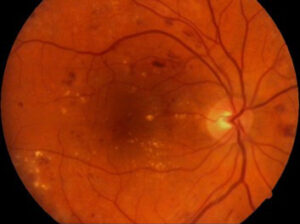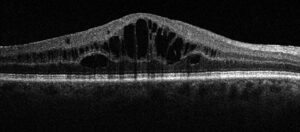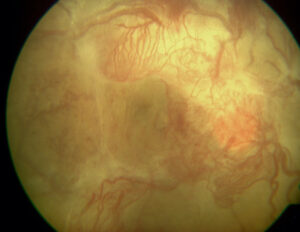A healthy retina is dependent upon good blood flow through healthy retinal vessels. High blood glucose levels seen in diabetes eventually cause damage to the blood vessels in the retina as well as to other blood vessels throughout the body. This retinal damage is called diabetic retinopathy or DR. DR is a leading cause of blindness in the US and is expected to increase as more people are diagnosed with diabetes every year. DR usually develops after several years of poorly controlled blood glucose levels and often is not associated with visual symptoms until late in the disease process. Early detection and treatment are key in preventing permanent visual loss.
There are two main stages of diabetic retinopathy. The disease begins as Non-Proliferative Diabetic Retinopathy (NPDR) and is often associated with diabetic macular edema (DME) as the disease progresses.

Diabetic Macular Edema, by Ratimir Lazic, MD, PhD from Retina Image Bank.

Diabetic Macular Edema seen with Optical Coherence Tomography (OCT)
Proliferative Diabetic Retinopathy (PDR) occurs in the more advanced stages and involves the growth of abnormal blood vessels due to lack of oxygen in the retina. These abnormal vessels are fragile and may hemorrhage leading to sudden onset of loss of vision. If not treated, tractional retinal detachments may develop which can lead to total permanent blindness.

Proliferative Diabetic Retinopathy, by Gabriela Lopezcarasa Hernandez, MD from Retina Image Bank, 2012
Treatment
The primary goal to prevent or halt diabetic retinopathy is to maintain blood glucose levels within a normal range, ideally with a hemoglobin A1C less than 7.0. Maintaining normal blood pressure and cholesterol levels is also important as well as is smoking cessation.
Certain criteria are used to determine when treatment of diabetic retinopathy is indicated. While laser treatment was once the mainstay of treatment, new treatment options involving intraocular injections of medications began in 2005. Dr. Keithahn has been performing injections since then as over time they have become the standard of care for many manifestations of the disease. Laser treatment is still useful in certain disease scenarios.
In more advanced phases of the disease, surgical intervention involving vitrectomy may be necessary. Dr. Keithahn has been performing vitrectomy surgery since 1994 and has been a part of a remarkable evolution in the field with improvements in surgical instrumentation and technology allowing enhanced surgical success.

